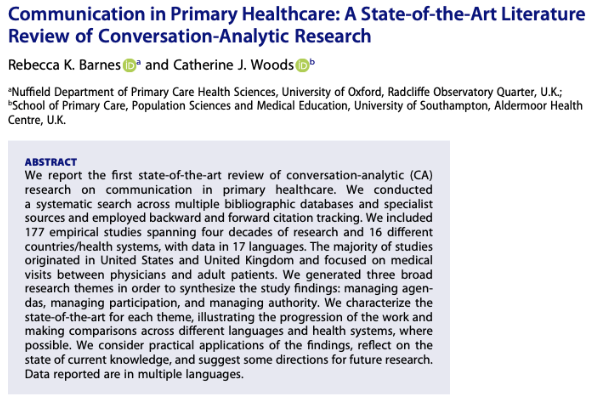A recent issue of the journal features eight specially commissioned articles describing the state of play in CA research on medical attraction. The contributors covered the ground from emergency to palliative care, and everything in between. But doing a really solid job on identifying the state of the art is no easy matter, and I’m delighted that one of the contributors, Catherine Woods has given us an account of the work involved.
In 2022 Becky Barnes and I were meeting on Teams once a month to discuss ongoing papers from the most recent project we worked on together. We often met on a Friday afternoon to discuss goals and writing, but only if we both managed to clear our main work and meetings for the week. Funnily enough, when there is a promise of talking about all things CA with a colleague you enjoy working with and just before the weekend, you always work efficiently during that week.
During one of our meetings, Becky mentioned a state-of-the-at review she was about to embark on for ROLSI, at first with excitement, then with trepidation at the prospect of reviewing 40 years’ worth of CA research in primary care…alone.
After some discussion and a ‘only take this on if you’re sure’, ‘sleep on it’, and a ‘yes of course I am’ kind of vibe, we agreed that completing the review together would allow us to produce a high-quality and rigorous piece of work based on our extensive experience of working and conducting CA research in primary care departments. We started working on our review in April.
How to be systematic
One of the first tasks of our review was establishing how we were going to be systematic in our methods and collaborative in our approach while working remotely. This included finding a definition of ‘primary care’ that applied across different health systems, and agreeing inclusion and exclusion criteria for the articles within our review. To help with screening, Becky suggested we use a software programme called ‘Rayyan’ which is commonly used for systematic reviews. It allows authors to screen abstracts and full papers independently within the same ‘project’ and highlights any discrepancies, which can then be discussed in subsequent meetings.
This process of defining the parameters of our review and sifting through the literature took a long old time, but by the end we were confident that the 177 articles included were comparable.
Once we had the full-texts of the articles we needed from our respective libraries, or by contacting authors directly (thank you!), we set our minds to ‘extracting’ key information related to: setting, study aim, participants, data, study findings and any practical recommendations. We knew that was going to be laborious, but there was no getting away from it: if this was good to be a proper state of the art review, then everything had to be gone through patiently and systematically.
We extracted detailed information from each study because: a) we wanted to be thorough, but also b) we each had about 90 articles to read/extract and did not want to have to redo anything at a later stage (which might have killed us off, to be honest).
Diving in and delving
The journey into the literature was rewarding for both of us, it involved revisiting familiar studies (or old friends, as it felt like) and discovering new ones. It also provided an opportunity for deep reflection on our field. We felt humbled and proud of our peers for moving the field of healthcare communication to where it is today.
Test, refine, get reviews, finalise
Finally came the last part of the review which involved organising the articles into themes and writing up our findings. As we had worked remotely for the duration of the review, we decided to meet in-person for this part, so we could share ideas more freely, brainstorm and *maybe* have a glass of something red together. After this two-day meeting, we had agreed preliminary themes and a shape to our review which we tested, refined and, following peer and editorial review, eventually became the published article that you see today.
Cost and reward
The process of writing a review article, that is systematic and rigorous in its approach, does take a long time but it is incredibly rewarding. We have produced a review that we hope is a useful resource for anyone interested in CA research about primary care.
We have also created a dataset which we plan to update each year to make the next review easier to complete. Being the only two people with access to this dataset does mean that we are not allowed to travel together anymore (car or flight) just in case something awful happens, but it’s worth it for what we’ve produced.
My advice to anyone thinking about conducting a review about CA research in the future is to say ‘yes’ – but be prepared to work hard; make sure you and your collaborator(s) are invested as the process will be arduous at times, especially if you have to fit it around other commitments; plan regular meetings and stick to them; choose tools that will enable you to keep track of everything and easily, in case you have to step away from the project; and, most importantly, be creative, have fun and trust the process – you will get there.
Fast forward 2 years from embarking on this review, and Catherine and Becky are working together at the University of Oxford, on a study exploring the management of patient risk in urgent primary care settings. They welcome enquiries about their review, as well as future research collaborations on communication in healthcare.
Emails: catherine.woods@phc.ox.ac.uk & rebecca.barnes@phc.ox.ac.uk




